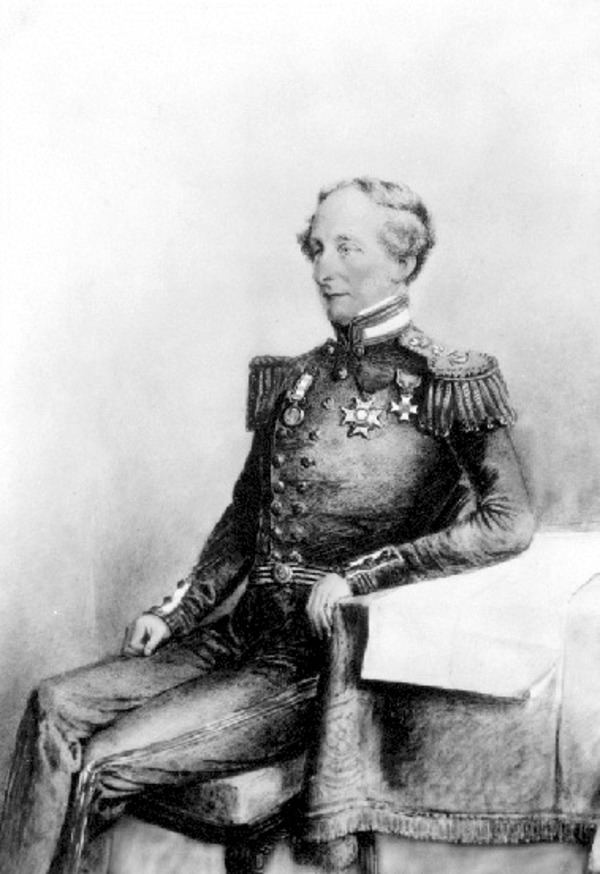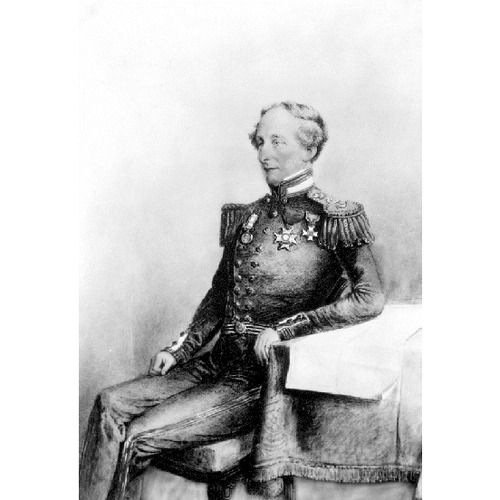
Source: Link
BAYNES, Sir ROBERT LAMBERT, naval officer; b. 1796, youngest son of Thomas Baynes, commander in the Royal Navy, and his wife Edith; m. in 1846 Frances, daughter of Thomas Denman, lord chief justice of England; d. 7 Sept. 1869 at Upper Norwood (now in London), England.
Robert Lambert Baynes entered the Royal Navy on 19 April 1810 and was promoted lieutenant on 8 April 1818. He served on Asia at the battle of Navarino in 1827, during the Greek War of Independence, and received a cb, three foreign decorations, and a captaincy. He was promoted rear-admiral on 7 Feb. 1855, serving in the Baltic, and was appointed commander-in-chief of the Pacific station at Valparaiso, Chile, on 8 July 1857, in Ganges, an 84-gun ship of the line.
On 28 June 1858 the Admiralty instructed Baynes to ascertain that a sufficient naval force was on the northwest coast of North America to maintain law and order in the gold mining districts of British Columbia, then being invaded by Californian adventurers, and thus to uphold British sovereignty. Baynes arrived in Ganges at Esquimault on 17 Oct. 1858 and was among the official party at Fort Langley when the new colony of British Columbia was proclaimed on 19 Nov. 1858. He was responsible for ensuring that naval vessels were available for maintaining order and also for implementing Governor James Douglas*’ regulations on mining. With winter approaching, however, the miners were leaving for California and Baynes was able to report to the Admiralty that all was quiet.
Baynes and the Ganges were absent from Esquimault between 22 Dec. 1858 and 5 Aug. 1859, attending to other station duties at Callao in Peru, and Valparaiso. Meanwhile the Anglo-American dispute over control of San Juan Island in lower Puget Sound had developed. On 27 July 1859 American soldiers under the orders of Brigadier-General William Selby Harney landed on the island to protect Americans against the alleged hostility of British colonial officials. Douglas wished the Royal Navy to land marines and oust them but Captain Geoffrey Thomas Phipps Hornby of Tribune, who replaced Baynes in his absence, refused. So too did Baynes on his return to Esquimault. As John T. Walbran* put it, “Neither the provocation of his enemies nor the rashness of his friends would allow him to hurry into ill-considered action, though he had an ample force to have prevented them landing or to effect their capture afterwards.” Douglas’ policy, Baynes said, would have resulted in war. As a compromise, Baynes urged a joint Anglo-American civil occupation of the island, but the American suggestion of a joint military occupation was adopted by the two governments towards the end of 1859. Both nations continued to maintain a military presence on San Juan until 1872 when Kaiser Wilhelm I offered his services as arbitrator and awarded the entire San Juan archipelago to the United States.
Both the Fraser River gold rush and the San Juan boundary dispute strengthened Baynes’ conviction that the protection of British interests would be best served by the transfer of naval station headquarters from Valparaiso to the North Pacific. After Captain George H. Richards* in Plumper had completed surveys of possible sites, Baynes strongly recommended Esquimault to the Admiralty in November 1859 as the most suitable harbour. Although cabinet changes in Britain caused delays, the Admiralty adopted Esquimault as the Pacific station headquarters in 1862.
Baynes received a kcb on 18 April 1860, for what the Duke of Somerset, first lord of the Admiralty, termed the “good sense and prudence” he exhibited during the “intemperate proceedings” of General Harney. Criticism by Douglas, the colonial legislature, and the Victoria press of his policy of non-intervention died down by the time Baynes left Esquimault on 10 Sept. 1860. He left in Ganges for England which he reached on 27 April 1861, having completed 60,100 sea-miles during his four years as commander-in-chief. He was not employed again by the Royal Navy but, as was customary, advanced on the active list to vice-admiral in 1861 and admiral in 1865. During his visits to British Columbia he had painted water-colour landscapes, some of which are in the Provincial Archives in Victoria.
Maritime Museum of B.C. (Victoria), “H.M.S. Ganges, 1821–1929,” [comp. P. W. Brock] (typescript). National Maritime Museum (London), Baynes coll., BAY/1–3. PABC, Colonial correspondence, Navy, H.M.S. Ganges correspondence. PRO, Adm. 1/5694, Y108, Y132, Y135, Y156; 1/5713, Y146; 1/5720, Y30; 1/5736, Y1, Y71; CO 60/1, 60/5–6, 305/12. B. M. Gough, The Royal Navy and the northwest coast of North America, 1810–1914: a study of British maritime ascendancy (Vancouver, 1971), 134–43, 161–66; “British policy in the San Juan boundary dispute, 1854–72,” Pacific Northwest Quarterly (Seattle, Wash.), 62 (1971), 59–68; “‘Turbulent frontiers’ and British expansion: Governor James Douglas, the Royal Navy, and the British Columbia gold rushes,” Pacific Hist. Rev. (Berkeley, Calif.), XLI (1972), 15–32.
Cite This Article
Barry M. Gough, “BAYNES, Sir ROBERT LAMBERT,” in Dictionary of Canadian Biography, vol. 9, University of Toronto/Université Laval, 2003–, accessed December 21, 2025, https://www.biographi.ca/en/bio/baynes_robert_lambert_9E.html.
The citation above shows the format for footnotes and endnotes according to the Chicago manual of style (16th edition). Information to be used in other citation formats:
| Permalink: | https://www.biographi.ca/en/bio/baynes_robert_lambert_9E.html |
| Author of Article: | Barry M. Gough |
| Title of Article: | BAYNES, Sir ROBERT LAMBERT |
| Publication Name: | Dictionary of Canadian Biography, vol. 9 |
| Publisher: | University of Toronto/Université Laval |
| Year of publication: | 1976 |
| Year of revision: | 1976 |
| Access Date: | December 21, 2025 |



